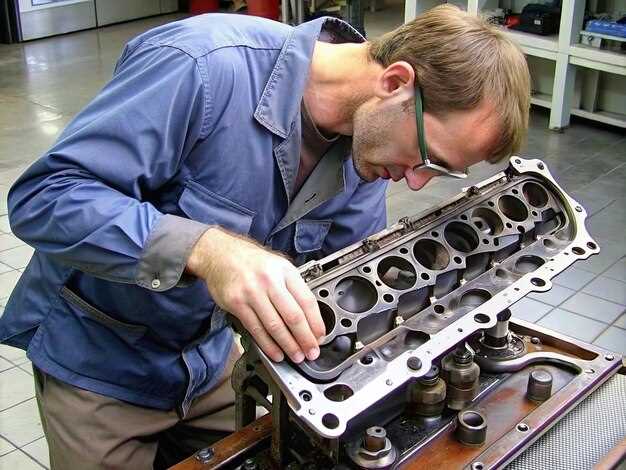
One of the critical components of your BMW’s engine is the head gasket, which plays an essential role in sealing the cylinder head to the engine block. A faulty gasket can lead to several performance issues that, if left unchecked, may result in significant engine damage. Identifying these issues early can save you time and money on costly repairs.
Issues related to the head gasket often manifest in various ways, such as overheating, loss of coolant, or oil contamination. These problems not only impact the overall efficiency of your vehicle but also threaten its longevity. Regular inspections of the head gasket can help detect early signs of failure, allowing you to address them before they escalate into severe engine complications.
During your inspection, it is crucial to look for specific indicators that may suggest gasket deterioration. Leaks, discoloration, or warping around the gasket surface are all warning signs that should not be ignored. By understanding the importance of the head gasket and knowing how to inspect it for potential issues, you can ensure that your BMW continues to perform at its best for years to come.
Identifying Symptoms of Head Gasket Failure in Your BMW
When it comes to your BMW, a failing gasket can lead to serious engine issues. Recognizing the signs early can save you time and money. One of the most common symptoms of head gasket failure is an overheating engine. If your temperature gauge consistently reads higher than normal, it may indicate that coolant is leaking due to a compromised gasket.
Another warning sign is white smoke coming from the exhaust. This indicates that coolant is entering the combustion chamber, resulting in a mixture that produces visible exhaust. Additionally, check for oil and coolant mixing; if you see a milky substance on the oil dipstick or inside the oil filler cap, it suggests that the head gasket may be damaged.
Loss of engine power can also signal a problematic gasket. If your vehicle struggles to accelerate or maintain speed, it might be a result of compression loss caused by a failed gasket. Furthermore, keep an eye on the coolant levels; a continually dropping level without any visible leaks can be a clear indicator of head gasket issues.
Finally, listen for unusual sounds from the engine. Banging or knocking noises can signify that the internal components are not functioning properly due to the head gasket failure. Timely identification and resolution of these symptoms can help prevent extensive damage to your BMW’s engine.
Steps to Properly Inspect Your BMW Head Gasket

Inspecting your BMW head gasket is crucial in identifying performance issues related to the engine. Follow these steps to conduct a thorough inspection:
1. Visual Inspection: Begin with a visual check of the engine bay. Look for any signs of oil or coolant leaks around the head gasket area. Discoloration, residue, or stains can indicate potential issues.
2. Check for Overheating: Pay attention to your engine temperature gauge. Persistent overheating can lead to head gasket failure. If your vehicle runs hotter than normal, it’s essential to investigate further.
3. Compression Test: Perform a compression test on each cylinder. Uneven compression readings can suggest leaks in the head gasket. Compare the results to ensure they fall within the manufacturer’s specifications.
4. Coolant Condition: Inspect the coolant for contaminants. Oil in the coolant or a milky texture can signal that the head gasket has failed, allowing oil to mix with the coolant.
5. Smoke Emissions: Observe the exhaust for unusual smoke. Blue smoke may indicate oil burning, while white smoke could mean coolant entering the combustion chamber, pointing to head gasket issues.
6. Pressure Test: Conduct a cooling system pressure test. This test checks for leaks in the system, revealing if the head gasket is compromised by maintaining pressure under certain conditions.
7. Listen for Noises: Pay attention to any unusual noises coming from the engine, such as knocking or bubbling sounds. These can indicate air leaks or other issues associated with the head gasket.
8. Consult a Professional: If you suspect any issues, it may be best to consult with a qualified mechanic. They have the tools and expertise to perform an in-depth assessment and recommend necessary repairs.
By following these steps, you can effectively inspect your BMW head gasket and address any performance issues before they escalate into more severe engine problems.
Repair Options and Considerations for BMW Head Gasket Problems

When encountering head gasket problems in your BMW, it is crucial to assess the extent of the damage before deciding on a repair strategy. The head gasket plays a vital role in sealing the engine block and cylinder head. Failure can lead to significant engine performance issues, including overheating and loss of compression.
There are various repair options available. One approach is to use a head gasket sealer, which can sometimes offer a temporary fix for minor leaks. However, this should be seen as a short-term solution, and reliance on sealants can lead to more extensive engine problems in the long run.
For more serious issues, a complete head gasket replacement is often necessary. This process involves removing the engine head, which requires significant mechanical expertise and time. It’s essential to ensure that the replacement gasket is of high quality, as subpar materials can lead to premature failure.
In addition to the gasket replacement, it’s important to inspect related components during the repair process. This includes checking the engine head for warping or cracks, as these conditions can compromise the new gasket’s effectiveness. If the head is damaged, it may need to be machined or replaced altogether, significantly increasing repair costs.
Cost is a significant consideration in the decision-making process. A complete head gasket replacement, including labor and potential additional repairs, can be expensive. Owners should weigh the potential benefits of repair against the cost of replacement versus investing in a new or rebuilt engine.
Finally, it’s advisable to consult with a qualified BMW technician. They can provide insights into the specific issues your model may encounter and recommend the most effective repair strategy tailored to your engine’s needs. Proper diagnosis and repair can greatly extend the engine’s life and enhance overall vehicle performance.



